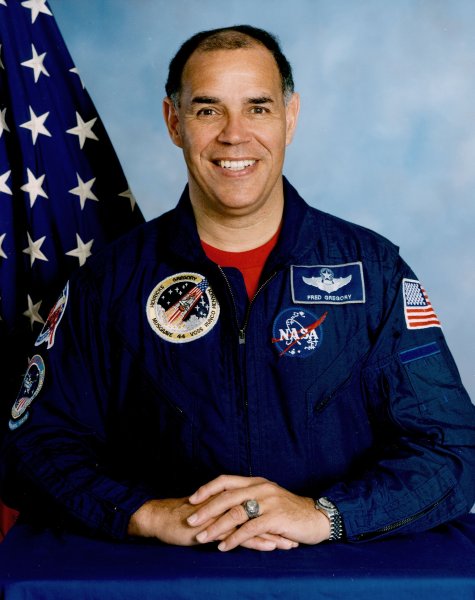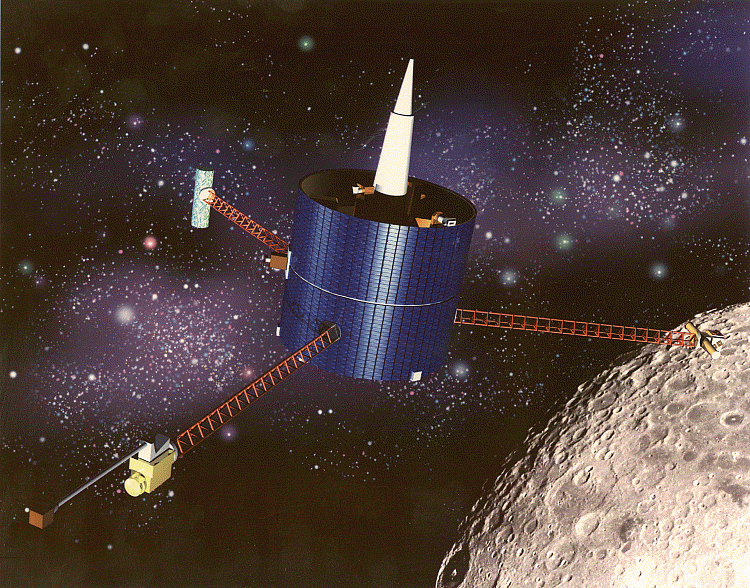If you are not already a subscriber, you are welcome to enter your email address here to sign up to receive the Space History newsletter on a daily basis. Under no circumstances will we release your legitimate email address entered here to outside persons or organizations, and it will only be used for mailing the specific information you have requested.
| Enter your email address here: |
Unsubscribe instructions are included in every newsletter issue in case you decide you no longer wish to receive it.
Note: We record the IP address from which subscriptions are entered to help prevent SPAM abuses.
Race To Space
Someone will win the prize...
... but at what cost?
Visit RaceToSpaceProject.com
to find out more!
1610
Galileo Galilei discovered the first three of Jupiter's four largest moons (Io, Europa, and Callisto). The four are called the "Galilean moons" in his honor.
ref: solarviews.com
1785
French inventor Jean-Pierre Blanchard and American Dr. John Jeffries made the first crossing of the English Channel by air, in a balloon.
ref: en.wikipedia.org
1834
Born, Johann Philipp Reis, German physicist and inventor (telephone)
Johann Philipp Reis (7 January 1834 - 24 January 1874) was a self-taught scientist and inventor who constructed one of the first working telephones, in 1860 (16 years before Bell's invention), covering a distance of 100 m. However, the transmitter Reis used was based on interrupting the current in the circuit, with a spring to close the contact after it had been opened by the shock of a vibration. As long as the sound was a musical tone it proved efficient, for a musical tone is a regular succession of vibrations. The vibrations of speech are instead irregular and complicated, and in order to transmit them the current has to be varied in strength without being altogether broken. Consequently, the instrument Reis built could send music fairly well, but was quite poor at transmitting speech.
ref: en.wikipedia.org
1893
Died, Josef Stefan, Slovene physicist, mathematician and poet (black body radiation)
Joseph Stefan (24 March 1835 - 7 January 1893) was a Slovenian physicist, mathematician and poet. He published nearly 80 scientific articles, mostly in the Bulletins of the Vienna Academy of Sciences. He is best known for originating a physical power law in 1879 stating that the total radiation from a black body is proportional to the fourth power of its thermodynamic temperature, but his studies included a wide range of other subjects in physics such as diffusion, heat conduction and electromagnetic radiation.
ref: en.wikipedia.org
1896
A. Charlois discovered asteroids #410 Chloris and #411 Xanthe; and M. Wolf discovered asteroids #412 Elisabetha and #413 Edburga.
1904
Born, John H. Lawrence, American physicist and physician best known for pioneering the field of nuclear medicine, examined the effect of neutron radiation on fabric
ref: en.wikipedia.org
1911
A day in infamy, the first airplane bombing experiments with explosives were performed in San Francisco.
ref: www.wright-brothers.org
1913
F. Kaiser discovered asteroid #738 Alagasta.
1913
William M. Burton received a patent for his process to "crack" petroleum.
ref: books.google.com
1927
Commercial transatlantic telephone service was inaugurated between New York City and London.
ref: en.wikipedia.org
1929
"Buck Rogers" premiered, the first science fiction comic strip.
ref: en.wikipedia.org
1934
K. Reinmuth discovered asteroids #1297 Quadea, #1298 Nocturna and #3264.
1934
The "Flash Gordon" comic strip (by Alex Raymond) debuted.
ref: en.wikipedia.org
1935
Born, Valeri Nikolayevich Kubasov (at Vyazniki, Vladimir Oblast, Russian SFSR), Soviet cosmonaut (Soyuz 6, Soyuz 19 (the Apollo-Soyuz mission), Soyuz 36/Salyut 6; nearly 18d 18h total time in spaceflight) (deceased)

ASTP cosmonaut Valeri N. Kubasov, NASA photo (25 April 1974)
Source: Wikipedia (spaceflight.nasa.gov killed 25 Feb 2021)
Valeri Nikolayevich Kubasov (7 January 1935 - 19 February 2014) was a Soviet cosmonaut who flew on two missions as a flight engineer in the Soyuz program, Soyuz 6 and Soyuz 19 (the Apollo-Soyuz mission), and commanded Soyuz 36 in the Intercosmos program. He was also involved in the development of the Mir space station. He retired from the Soviet space program in March 1993.
Kubasov "cheated death" twice during his space career: He was part of the crew originally intended to fly Soyuz 2, which was found to have the same faulty parachute sensor that resulted in Vladimir Komarov's death on Soyuz 1 and was later launched without a crew. Later, he was grounded for medical reasons before the Soyuz 11 flight, whose back-up crew was killed when the capsule was accidentally depressurized by a faulty valve.
Kubasov was later deputy director of RKK Energia.
Kubasov died in Moscow of natural causes.
See also Wikipedia
ref: www.spacefacts.de
1940
G. Kulin discovered asteroid #3019.
1941
Born, Frederick D. Gregory, (at Washington, DC, USA), Colonel USAF, NASA astronaut (STS 51-B, STS 33, STS 44; over 18d 23h total time in spaceflight), NASA Deputy Administrator (2002-2005)

Astronaut Frederick D. Gregory, NASA photo
Source: Wikipedia (www.jsc.nasa.gov unavailable January 2020)
ref: en.wikipedia.org
1943
Died, Nikola Tesla, Serbian-born inventor, electrical engineer
Nikola Tesla (10 July 1856 - 7 January 1943) was a Serbian-American physicist, inventor, and electrical engineer of unusual intellectual brilliance and practical achievement. Tesla is most famous for conceiving the rotating magnetic field principle (1882) and then using it to invent the induction motor together with the accompanying alternating current long-distance electrical transmission system (1888). His theoretical work and patents still form the basis for modern alternating current electric power systems. He also developed numerous other electrical and mechanical devices including the fundamental principles and machinery of wireless technology, the high frequency alternator, the "AND" logic gate and the Tesla coil, as well as other devices such as the bladeless turbine, the spark plug and many other inventions.
Rumors and speculations abound about the extent of Tesla's inventions, in part because his laboratory burned and most of his notes were destroyed. One notable story is of a Pierce Arrow apparently powered by a small box of parts assembled from a radio store in the early 1930s. While some reports speculate the "black box" that powered the car operated from cosmic energy, it is possible the device could have existed, powered from electrical power transmission systems Tesla was then working on.
ref: en.wikipedia.org
1951
Born, Talgat Amangeldyyevich Musabayev (at Kargaly, Dzhampul Oblast, Kazakh SSR), Russian major, cosmonaut (Mir 16, Mir 25, Soyuz TM-32/ISS taxi; over 341d 9.75h total time in spaceflight)

Cosmonaut Talgat Musabayev aboard the ISS, NASA photo (June 1998)
Source: Wikipedia
ref: www.spacefacts.de
1967
The last engineering data was received from NASA's Surveyor 1 spacecraft on the Lunar surface.
ref: nssdc.gsfc.nasa.gov
1975
P. Wild discovered asteroid #3468.
1976
E. F. Helin discovered asteroid #2062 Aten.
1983
The world's first solar-powered car capable of transporting humans, the Quiet Achiever (BP Solar Trek), ended its 20 day journey across Australia at the Sydney Opera House, having traveled 2,560-mile (4,130-km) from Scarborough.
ref: en.wikipedia.org
1998 02:28:44 GMT
NASA launched the Lunar Prospector Moon orbiter for a low polar orbit investigation of the Moon.

Lunar Prospector in orbit at the Moon, NASA artist conception
Source: NSSDCA Master Catalog
The Lunar Prospector, launched 7 January 1998, was designed for a low polar orbit investigation of the Moon, including mapping of surface composition and possible deposits of polar ice, measurements of magnetic and gravity fields, and study of Lunar outgassing events. Data from the 19 month mission allowed construction of a detailed map of the surface composition of the Moon, and improved the understanding of the origin, evolution, current state, and resources of the Moon. The spacecraft carried 6 experiments: a Gamma Ray Spectrometer (GRS), a Neutron Spectrometer (NS), a Magnetometer (MAG), an Electron Reflectometer (ER), an Alpha Particle Spectrometer (APS), and a Doppler Gravity Experiment (DGE). The instruments are omnidirectional and require no sequencing. The normal observation sequence was to record and downlink data continuously. The mission ended on 31 July 1999 at 9:52:02 UT (5:52:02 EDT) when Lunar Prospector was deliberately targeted to impact in a permanently shadowed area of a crater near the Lunar south pole. It was hoped that the impact would liberate water vapor from the suspected ice deposits in the crater and that the plume would be detectable from Earth, however, no plume was observed.
ref: nssdc.gsfc.nasa.gov
We are going to run out of oil!
Visit SpacePowerNow.org
to help fix the problem.
SpacePowerNow.org - For Human Survival
Please help support our efforts by shopping from our sponsors.
This newsletter and its contents are Copyright © 2006-2025 by The L5 Development Group. All rights reserved. - Publication, in part or in whole, requires previous written permission. - Academic or personal-use citations must refer to http://L5Development.com as their source. Thank you for your cooperation.
Space History Department
Resources
The L5 Development Group Home Page
The L5 Development Group Keyword Access System
Space History for January 7 /
Webmaster /
Script last modified August 23, 2018 @ 6:05 am
Copyright © 2006-2025 by The L5 Development Group. All rights reserved.
Hosted by FKEinternet




